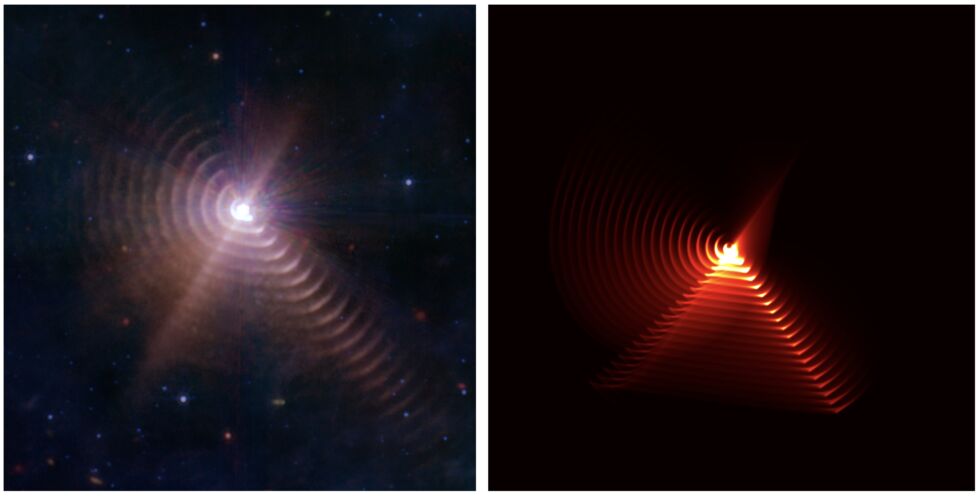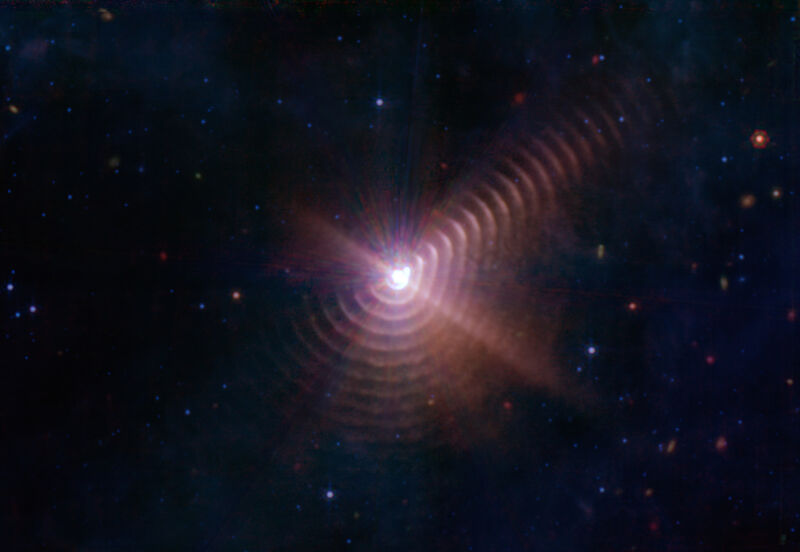Over the past 120 years, stellar winds have built concentric circles of dust.
Today, Nature Astronomy released a paper that shows off the sorts of science the Webb Telescope was designed to produce. Early on, the new telescope was pointed at a system of two massive stars that orbit each other closely. Ground-based observations had detected a ring or two produced by the interactions of these giants; the Webb was able to determine that there are at least 17 concentric rings of material that have been put in place over the previous 130 years.
And just to show off, astronomers were able to obtain a spectrum of the material that forms the rings.
It's difficult to express just how bizarre these rings look (just check out the image yourself at the top of this article!). Yet modeling the forces that are thought to have put them in place produces a near-exact replica of the structures.
Rings around the giants
Known as WR 140, the system is composed of two massive stars. One is an O-type star, the largest and hottest class of stars we know of. The second is called a Wolf-Rayet, a class of massive stars that are so energetic, it ejects most of their hydrogen and often shed heavier elements like carbon or nitrogen into the environment. These two giants orbit each other closely enough that it takes less than eight years for one go-around, although the orbit is pretty eccentric.
Due to their highly energetic nature, both of these stars have powerful stellar winds that eject a lot of material into the surrounding space. And in places where their winds interact, pressures can get high enough that the winds condense into dust particles. Thanks to the orbital dynamics, this results in a partial ring-like structure, with most of the condensation taking place on one side of the binary. Observations with ground-based telescopes had revealed one or two rings extending out to roughly 5,000 times the Earth-Sun distance (called an Astronomical Unit, or AU).
Those structures looked interesting enough that WR140 was made a target for the Webb's Director’s Discretionary Early Release Science Program. And the images are truly spectacular, showing a series of up to 17 rings that extend roughly a light year from the binary stars. There are likely to be additional rings that extend even further but are too faint to detect.
The rings aren't entirely even, and they're thicker in some areas than others. These differences are overlayed across the diffraction spikes caused by the shape of Webb's mirrors and some associated hardware. But the diffraction spikes affect all wavelengths, while the features of the rings are much brighter at lower infrared energies, allowing the two to be distinguished.
In theory, the details of the rings, including their asymmetries, are controlled by the orbital interactions of the two stars. So the research team built a model that includes the orbital details and the winds produced by the two stars. The match between the model's output and what's actually visible in HR 140 is shockingly good, in that it accurately predicts a lot of the subtle details of the ring system. This suggests that we have a good grip on the physical forces creating this system, including the factors that create more dust at some points in the orbit than others.

If we assume there's a ring produced every orbit, the 17 present rings indicate about 130 years of ring production. Since they now extend out about a light-year, we can infer that they're moving away from the binary stars at about 2,600 kilometers every second.
While there are some irregularities, the expansion is impressively even, given that the ring material is experiencing variable gravitational pulls, radiation pressure from the stars, and drag from all the other material that has been ejected by the stars.
The Wolf-Rayet star in WR 140 is rich in carbon, which means a lot of the dust present in the rings should be correspondingly rich in organic chemicals. And thanks to the hardware in the Webb, we can confirm this. The chemical mixture appears to be very complicated, with no individual molecules standing out from the spectrum. But it seems to be rich with ringed, benzene-like structures, called polycyclic aromatic hydrocarbons. These tend to form in carbon-rich, hydrogen-poor environments—exactly what you'd expect from a carbon-rich Wolf-Rayet star.
With both physics and chemistry behaving exactly as expected, there's not much in the way of mysteries to be sorted out here. The information is useful for other areas of astronomy, as dust in the interstellar medium makes major contributions to star and planet formation, and these stars can help us understand how some of it got there.
But that's not to say it isn't worth spending some time being astonished by the fact that relatively easy-to-understand chemistry and physics can create the truly stunning structures that Webb has revealed.
- BobikH, Karlston and aum
-

 3
3




Recommended Comments
There are no comments to display.
Join the conversation
You can post now and register later. If you have an account, sign in now to post with your account.
Note: Your post will require moderator approval before it will be visible.